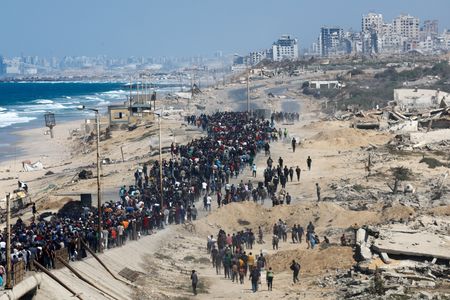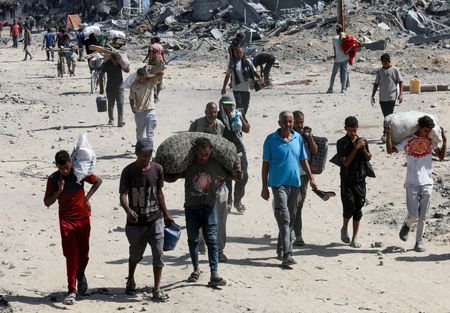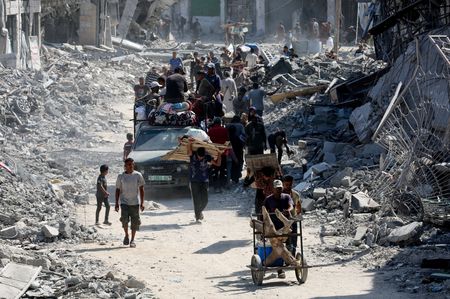By Alexander Cornwell and Nidal al-Mughrabi
JERUSALEM/CAIRO (Reuters) -Thousands of displaced Palestinians trekked over the wastelands of Gaza to return to the ruins of their abandoned homes on Friday, after a ceasefire took effect and Israeli troops began pulling back under the agreement to end the war.
A huge column of people filed on foot north along the coastal road overlooking sandy beaches towards Gaza City, the enclave's biggest urban area, which had been under attack just days ago in one of Israel's biggest offensives of the war.
"Thank God my house is still standing," Ismail Zayda, 40, said in the Sheikh Radwan district of Gaza City. "But the place is destroyed, my neighbours' houses are destroyed, entire districts have gone."
In the south, people picked their way through the dusty moonscape that was once Gaza's second-largest city, Khan Younis, which Israeli forces razed this year. Most walked in silence.
A middle-aged man, Ahmed al-Brim, was pushing a bicycle with bundles of scrap timber tied to the front and back: his family would need the firewood to cook. It was all they had been able to recover from the ruins of their home.
"We went to our area. It was exterminated. We don't know where we will go after that," he said. "We couldn't get the furniture, or clothes, or anything, not even winter clothes. Nothing is left."
NETANYAHU: HAMAS MUST DISARM 'EASY WAY' OR 'HARD WAY'
The Israeli military said the ceasefire agreement had been activated at noon local time (0900 GMT).
The first phase of U.S. President Donald Trump's plan to end the war between Israel and the Hamas militant group gives Israeli troops 24 hours to pull from positions in urban areas, although they will still hold more than half of Gaza.
Israeli police said they were preparing for Trump's visit on Monday that officials said would include a speech to the Knesset, Israel's parliament, the first by a U.S. president since George W. Bush in 2008.
Trump said he would head to the region on Sunday, perhaps to attend a signing ceremony in Egypt. Axios, citing four sources with knowledge of the matter, reported on Friday he plans to convene world leaders for a summit on Gaza while in Egypt.
The next phase of Trump's plan calls for an international body - the "Board of Peace" - to play a role in Gaza's post-war administration. The plan calls for Trump to lead it and includes former British Prime Minister Tony Blair.
In a televised address, Prime Minister Benjamin Netanyahu said Israeli forces were staying in Gaza to ensure Hamas was disarmed: "If this is achieved the easy way, then that will be good, and if not, then it will be achieved the hard way."
As the day wore on and it became clear troops were no longer blocking the roads into cities, an initial trickle turned into a flood of Palestinians returning from makeshift tented camps to the homes they had left behind.
Mahdi Saqla, 40, said his family had decided to set off north towards Gaza City as soon as they heard the news of the ceasefire.
"Of course there are no homes - they've been destroyed," he said. "But we are happy just to return to where our homes were, even over the rubble. That too is a great joy. For two years, we've been suffering, displaced from place to place."
Israel's government ratified the ceasefire with Hamas in the early hours of Friday. Once Israeli troops have pulled back, Hamas has 72 hours to release the 20 living Israeli hostages it is still holding. Israel will free 250 Palestinians serving long terms in its prisons and 1,700 detainees captured during the war. Hundreds of trucks per day are expected to surge into Gaza carrying food and medical aid.
Israeli military spokesperson Brigadier General Effie Defrin urged residents of Gaza to avoid entering areas under Israeli military control: "Keep to the agreement and ensure your safety," he said on Friday.
HAMAS GAZA LEADER SAYS HE RECEIVED GUARANTEES WAR IS OVER
Israelis and Palestinians alike rejoiced after the deal was announced, to end two years of war in which over 67,000 Palestinians have been killed, and to return the last hostages seized by Hamas in the deadly attack that provoked it.
The exiled Gaza chief of Hamas, Khalil Al-Hayya, said he had received guarantees from the United States and other mediators that the war was over.
During the Hamas-led attack on Israeli communities and a music festival on October 7, 2023, fighters killed 1,200 people and captured 251 hostages.
Twenty hostages are still believed to be alive in Gaza, while 26 are presumed dead and the fate of two is unknown. Hamas has indicated that recovering the bodies of the dead may take longer than releasing those who are alive.
HURDLES REMAIN
The accord, if fully implemented, would bring the two sides closer than any previous effort to halt the war.
Much could still go wrong. Further steps in Trump's 20-point plan have yet to be agreed. Those include how the demolished Gaza Strip is to be ruled when fighting ends, and the ultimate fate of Hamas, which has rejected Israel's demands it disarm.
The Hamas-run interior ministry said it would deploy security forces in areas where the Israeli army withdrew. It was not clear whether armed militants would return to the streets in significant numbers, a move Israel would see as a provocation.
(Reporting by Maayan Lubell in Jerusalem and Nidal al-Mughrabi in Cairo; additional reporting by Mahmoud Issa in Gaza, Ahmed Eleimam, Jana Chouceir and Tala Ramadan in Dubai, Howard Goller in New York; writing by Michael Georgy and Peter Graff; editing by Mark Heinrich, Rod Nickel)












